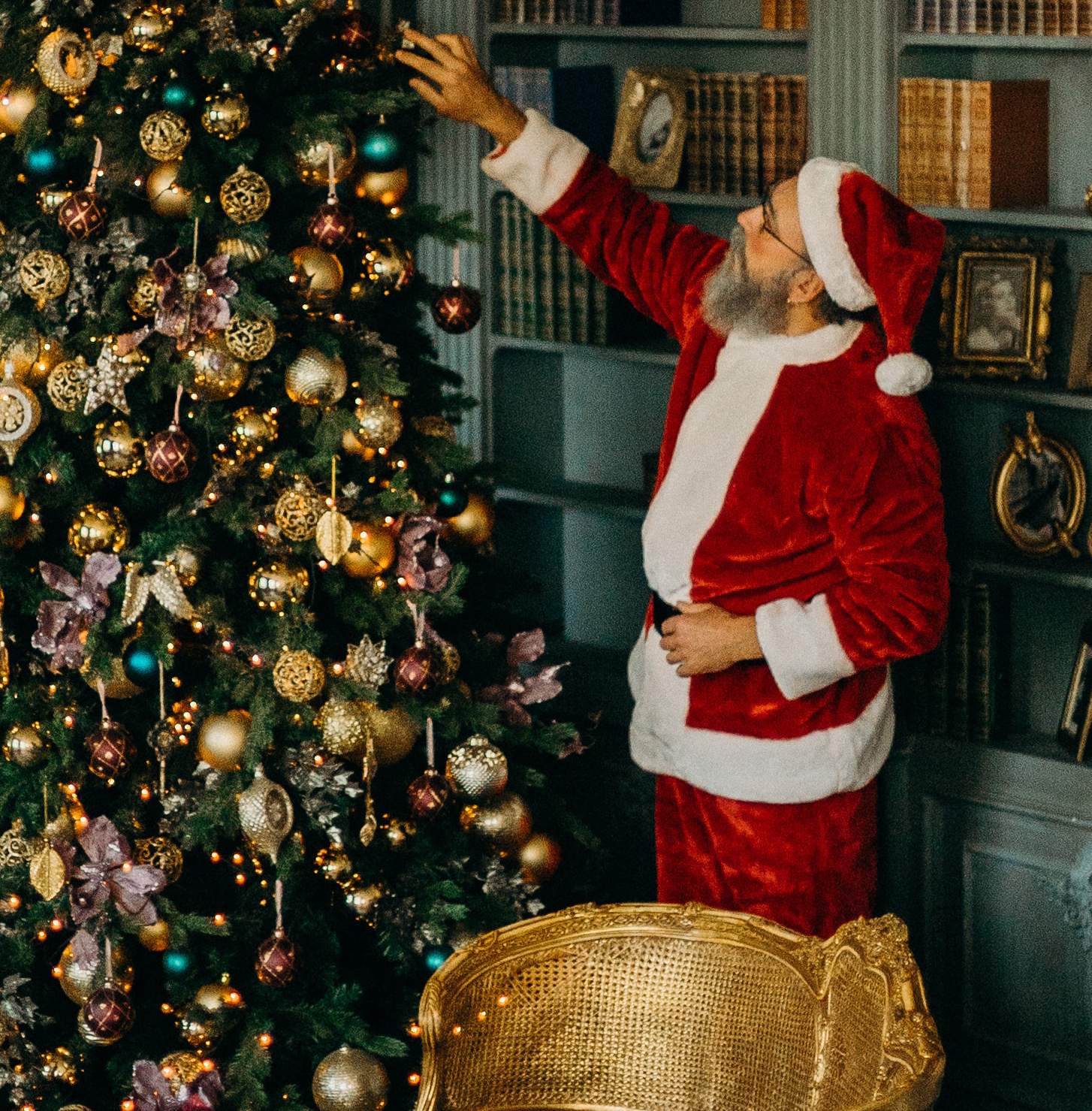How the Coca-Cola Christmas Advert changed Santa for life.


By Steve Hillyard
Which Christmas Advert is the best?
There are a few that make my short list here; John Lewis and Aldi, but for me you know it’s Christmas when you see the convoy of red trucks driving through a snowy landscape to the mantra of “Holidays are coming”, headed by Santa who’s knocking back a nice cold refreshing “Monroe” shaped bottle of Coca-Cola. Perfect!
Coca-Cola is possibly my favourite brand, I quite like the drink, but as a graphic designer, the branding is absolutely masterful. The brand is so strong that it has extended itself to influence our modern couture and even shape Christmas…
Did Coca-Cola create Santa?
No, no it didn’t.
Coca-Cola’s advertising didn’t create Santa but did play a big part in shaping the jolly character we picture when someone says ‘Santa’. Before 1931 there were many depictions of Santa Clause, from St. Nicholas, the Christian bishop of greek descent known for his generosity, to Krampus – a horned anthropomorphic character who would scare children who had misbehaved. The legend of Santa has its roots all over Europe from pagan folklore to Christian tradition, but it wasn’t until 1931 that Coca-Cola standardised the common image of Santa by commissioning the illustrator Haddon Sundblom to paint Santa Claus for a Christmas advertisement. Not saying that there weren’t depictions of Santa wearing scarlet like that before Coke adopted him, there definitely were. But certainly, the Coca-Cola Santa helped define the look and personality of the modern Father Christmas. Sundblom took his inspiration from the poem “A visit from St. Nicholas” (commonly known as “Twas the night before Christmas”) and from 1931 to 1965 Sundblom prolifically painted the Santa we associate with Christmas for Coca-Cola. Today Coca-cola still use Sundblom’s Santa at Christmas time – in adverts and on the packaging.
So who created Santa?
According to traditional Christian beliefs he is depicted as a friendly old man who visits the homes via the chimney of children who are generally well-behaved to leave them presents. That particular legend is said to have derived from St. Nicholas, who, according to several Christian denominations is said to be the patron saint of Children. However, in other countries around the world there are loads of other mythical figures who resemble Santa Claus in either appearance or actions:
Sinterklaas – According to legend in the Netherlands, Sinterklaas rides from house to house rewarding children for their good behaviour. It originated in the middle ages and was observed as a day to assist the poor in society. This legendary figure is from Saint Nicholas, a 4th Century Greek Christian Bishop. The feast of Sinterklaas begins on December 5th. The Sinterklass comes from Dutch for Saint (Sint) Nicholas (Nikolaas) over time this was shortened and then morphed into Santa Claus. Sinterklaas landed in New York in the 1770s when groups of Dutch families gathered to honour the death of St. Nicholas, as this point there was no standard image of Sinterklaas, he was said to wear a blue three-cornered hat, red waistcoat, yellow stockings, a broad-brimmed hat and a “huge pair of Flemish trunk hose.”
Befana – Italian legends tell of an old woman who annually gives gifts to children during Epiphany Eve on January 5th. Quite interestingly she would leave sweets and gifts to good kids, or a lump of coal to the naughtier ones. Befana also became known as “The Christmas Witch”
Mikulas – a legendary figure similar to Saint Nicholas all over central Europe, he would reward well-behaved children with gifts and sweets, but Mikulas has an accomplice, Krampusz, who would give children with poor morals a wooden spoon.
Krampus – If you were a child in Germany back in the day, Krampus is a figure you wouldn’t want visiting you. Unlike the above Krampusz, this Krampus is depicted as a half-goat half-demon creature who would punish children who have been naughty. While Santa Claus would reward the good kids.
Joulupukki – Generally celebrated in Norway, Joulupukki (loosely translates to “Yule Goat”) is a Scandinavian figure with a long white beard, wears a red coat with white fur trim and travels around on a sleigh pulled by reindeer leaving gifts for well-mannered children. The origin of Joulupukki is a mythical Norse figure but Christianity has incorporated this old pagan tradition and merged it with St. Nicholas, this is the closest description to the coca-cola standardised Santa.
Yule Lads – also known as “Yulemen”, according to Icelandic folklore were the sons of Gryla and Leppaludi, trolls who lived in the mountains. The Yule lads would descend from the mountains to prank and scare children who misbehave. They were accompanied by the Yule Cat, quite an unassuming name for a beast which would eat children who did not get new Yuletide clothes. Later on, the Yule Lads legend became 13 men who would travel around Iceland offering gifts to children with good morals.
Amu Nowruz – An Iranian fictional figure who is believed to appear at the start of spring. Like our Cola Santa he is said to be an old man with a white beard who visits children to give them gifts. Unlike our Cola-Santa he had an accomplice, Haji Firuz, who played the Tamborine and takes things from the ill-behaved kids.
Ded Moroz – Loosely translates to “Old Man Frost” Ded Moroz is still many Eastern Block countries equivalent to Santa. Ded Moroz, accompanied by his granddaughter Snegurochka is said to appear on New Year’s Eve to bring children presents. He’s also known to wear a blue coat and trousers. A valid alternative…
Nisse – According to Scandinavian folklore, a nisse is a gnome-like creature (about 60 to 70cm tall) with a white beard and a conical hat. He appears during the winter solstice to deliver gifts to the doors of well-behaving children. No breaking and entering for this little fellow, even though he’d probably find it easier to do so.
Olentzero – Is the Basque Santa, believed to visit towns to give gifts on Christmas Eve. Nothing particularly interesting about this chap, he is even said to be dressed like a Basque farmer, usually blue trousers and a sheepskin cape.
Christkind – Also known as Christkindl is a spirit-like child, usually with blonde hair and angel wings. He was created during the 16th century. His depiction is based on the common image of baby Jesus to symbolise the incarnation. He is popular all over the world, you would have definitely seen him as the little angel on top of trees, although he is a lot less conspicuous next to loud bright Coca-Cola’s Santa.
So there we have it. There are loads of Santas from all over the world, including a plump white-bearded jolly fellow in a red coat pulled around by reindeer who isn’t Santa! Coca-Cola has a habit of nailing whatever they do the first time. The drink formula was decided in a relatively short timeframe, the logo has gone quite unchanged since 1887, and they’ve standardised Santa.
Personally, as a character, I like Nisse, I went to Copenhagen over Christmas a few years ago and Nisse fits so well with the subtle Scandinavian patterns, style and Scandinavian colour pallets. But the image of a merry, kind, old man with a big red suit, rosy cheeks and twinkling eyes is exactly how the world loves to see Santa – and is perfect for selling Cola in winter too.
you may also like…
Ridding The Measurement Myths of Google Privacy Ads
Let us rid you of the myths associated with Google Privacy Ads and the all-important but not so tasty Cookies.
How To Drive Influencer Marketing Effectiveness
The Soshell team delve into how they organised and delivered a successful influencer campaign for eCommerce jewellers Joshua James Jewellery.
Moving To GA4: For Style Or Effectiveness?
Ready for GA4 yet? Find out how GA4 is different to Universal Analytics and determine whether it’s right for you in this article.


